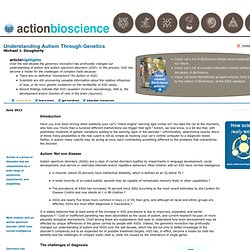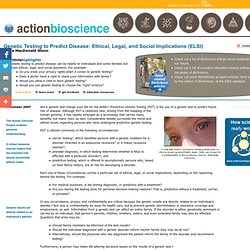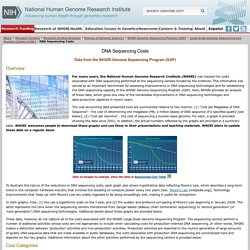

Should You Get Your Genome Mapped? Back in early 2010, molecular geneticist Michael Snyder, then a trim 54-year-old, decided to put his genetic blueprint under the microscope and make the results public.

Swabbing saliva from his cheek with a sterile sponge and drawing blood to obtain his DNA samples, the Stanford scientist became the subject of one of the first clinical studies to analyze the blueprint of a healthy individual rather than someone known to be sick. Snyder's study took advantage of recent technological advances that have now made it possible to rapidly and much less expensively sequence a genome—the instruction manual, contained in virtually every cell of a person, for making a human being. Containing some 3.2 billion pieces of genetic information, the genome determines a broad spectrum of human traits such as eye color, height, general health, and whether someone might be more likely to be a basketball player or a biologist. What the Stanford researcher found surprised him. The $1,000 mark. Ajhg00061-0120. Medical & Health Updates & News. Gene Privacy Protection Urged By Bioethics Panel.
WASHINGTON -- It sounds like a scene from a TV show: Someone sends a discarded coffee cup to a laboratory where the unwitting drinker's DNA is decoded, predicting what diseases lurk in his or her future.

A presidential commission found that's legally possible in about half the states – and says new protections to ensure the privacy of people's genetic information are critical if the nation is to realize the enormous medical potential of gene-mapping. Such whole genome sequencing costs too much now for that extreme coffee-cup scenario to be likely. But the report being released Thursday says the price is dropping so rapidly that the technology could become common in doctors' offices very soon – and there are lots of ethical issues surrounding how, when and with whom the results may be shared. Without public trust, people may not be as willing to allow scientists to study their genetic information, key to learning to better fight disease, the report warns. Human genome sequencing: the real ethical dilemmas. Good science fiction always tries to be thought-provoking about the present, not just the future.

Rarely has this been accomplished as successfully as in Andrew Nicoll's movie Gattaca. Released in 1997, just as the sequencing of the human genome neared completion, this dystopian vision portrayed a world divided by DNA. Understanding Autism Through Genetics. June 2013 Introduction Have you ever been driving when suddenly your car’s “check engine” warning light comes on?

You take the car to the mechanic, who tells you “more than a hundred different malfunctions can trigger that light.” Autism, we now know, is a bit like that, with potentially hundreds of genetic variations leading to the warning signs of the disorder.1 Unfortunately, determining exactly which of those many possibilities is the real culprit is not as simple as hooking your car’s central computer to a diagnostic tester. Rather, in autism many culprits may be acting at once, each contributing something different to the problems that characterize the disorder. Autism is a group of disorders that are characterized by a wide range of symptoms, impairments, and disabilities. Autism: Not one disease Most children with an autism spectrum disorder (ASD) have normal intelligence. Genetic Testing to Predict Disease: Ethical, Legal, and Social Implications (ELSI)
December 2007.

DNA Sequencing Costs. DNA Sequencing Costs Data from the NHGRI Genome Sequencing Program (GSP) Overview For many years, the National Human Genome Research Institute (NHGRI) has tracked the costs associated with DNA sequencing performed at the sequencing centers funded by the Institute.

Decoding the human genome. Kelly A.

Frazer1 + Author Affiliations Interpreting the human genome sequence is one of the major scientific endeavors of our time. In February 2001, when the human genome reference sequence was initially released (Lander et al. 2001), our understanding of the encoded contents was surprisingly limited. It was perplexing to many in the scientific community when we realized that the human genome contains only ∼21,000 distinct protein-coding genes (Claverie 2001; Hollon 2001; Pennisi 2003; Clamp et al. 2007), as other less complex species like the nematode Caenorhabditis elegans were known to have a similar number of protein-coding genes (Hillier et al. 2005).
The genomic complexity of primary human prostate cancer : Nature. The closed chain pattern of chromosomal breakpoints also raised the possibility that multiple genomic regions might become spatially co-localized before undergoing rearrangement.

Conceivably, such a phenomenon could reflect migration to ‘transcription factories’—preassembled nuclear subcompartments that contain RNA polymerase II holoenzyme30. In prostate cells, androgen signalling has been shown to induce co-localization of TMPRSS2 and ERG, thereby allowing double-strand breaks to facilitate gene fusion formation31, 32, 33. A role for transcription in the genesis of TMPRSS2–ERG in PR-1701 seems plausible, as genomic sequences of up to 240 bp are duplicated at the resulting fusion junctions (Fig. 2b). Alternatively, chains of breakpoints might reflect the clustering of active and inactive chromatin within the recently demonstrated fractal globule structure of nuclear architecture34. Human Genome Project leader warns against attempts to patent genes. The Human Genome Project, 3D Animation.